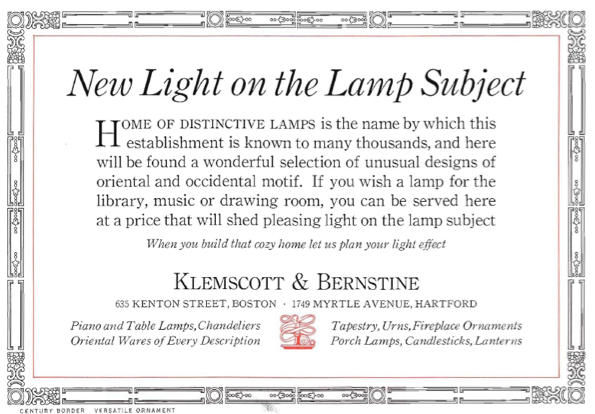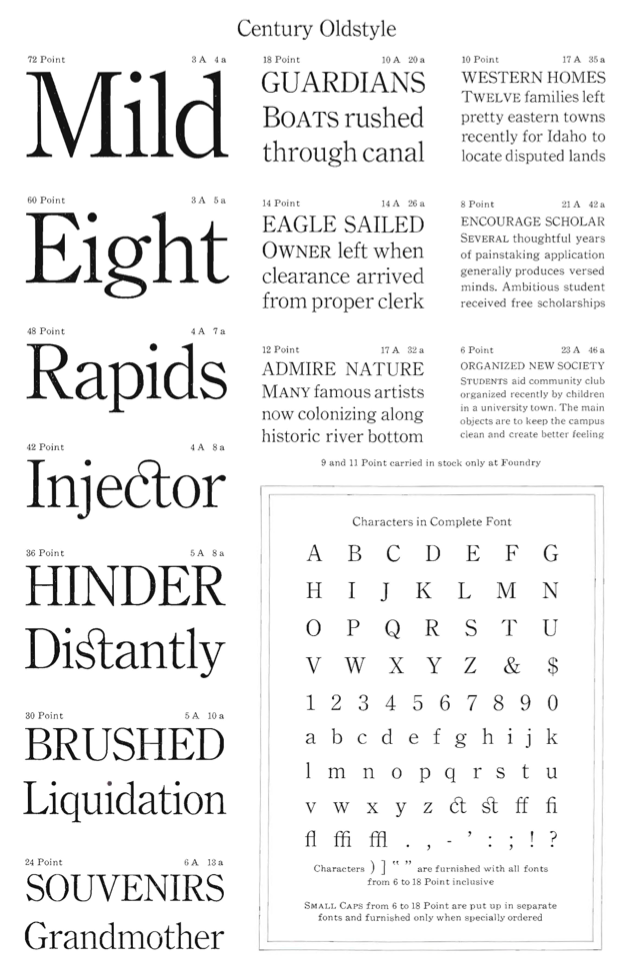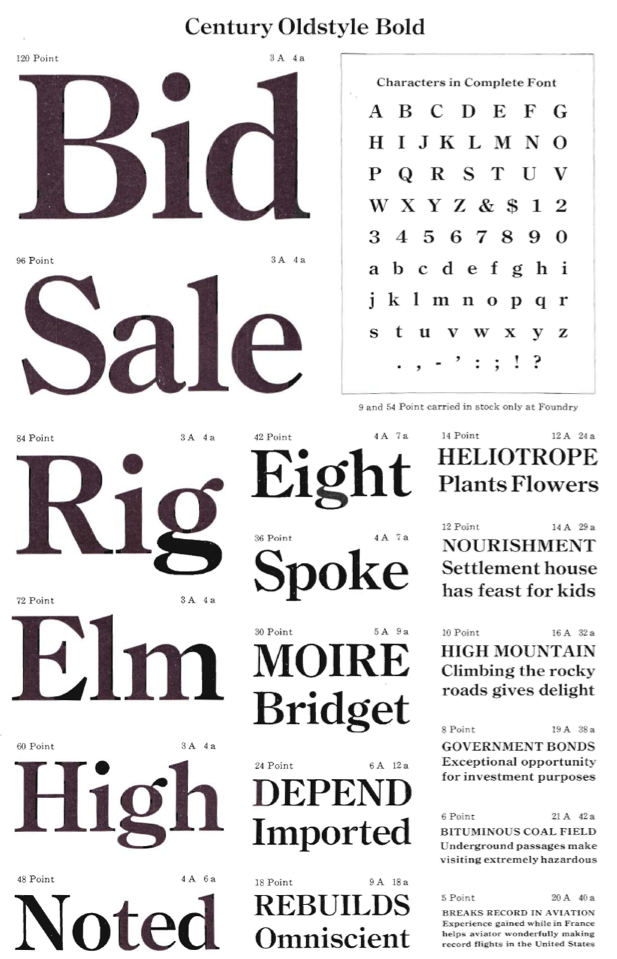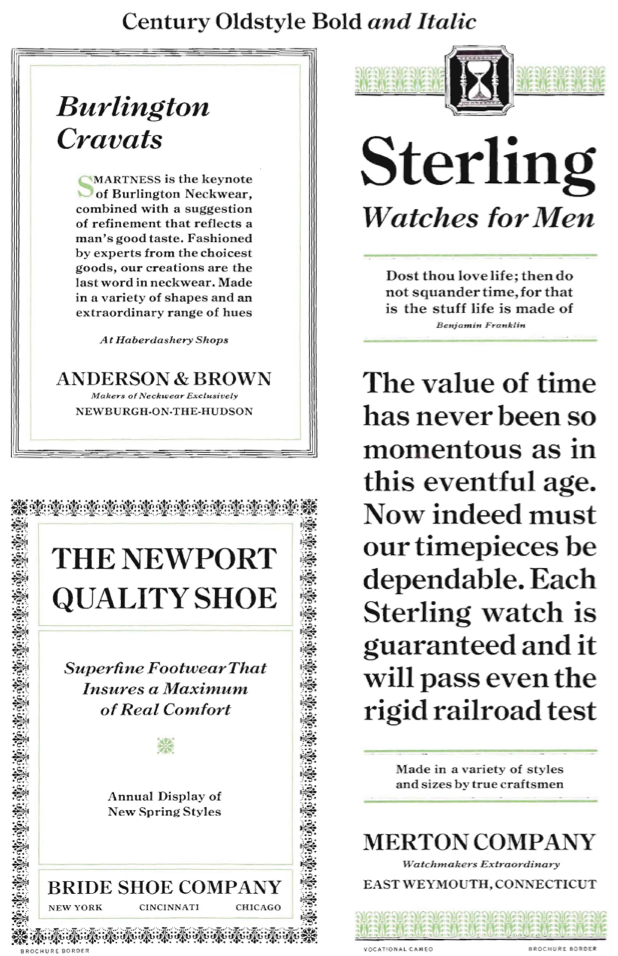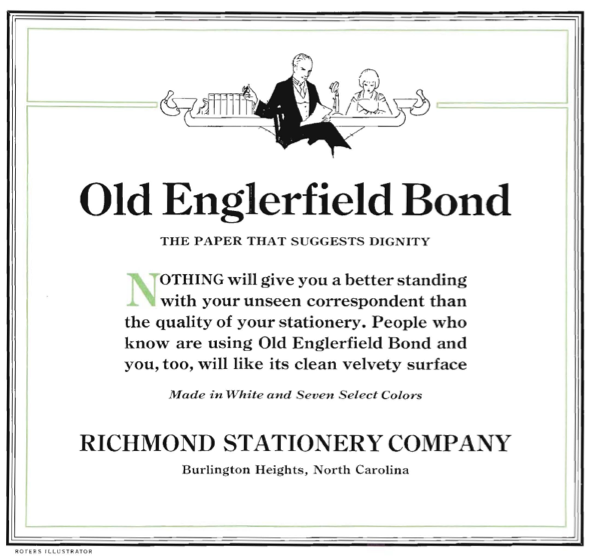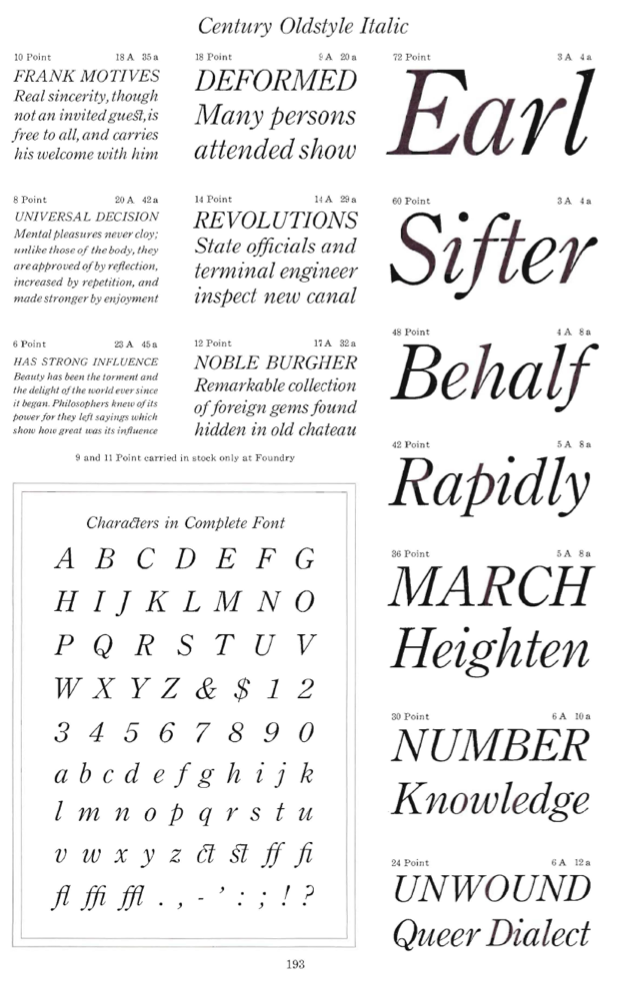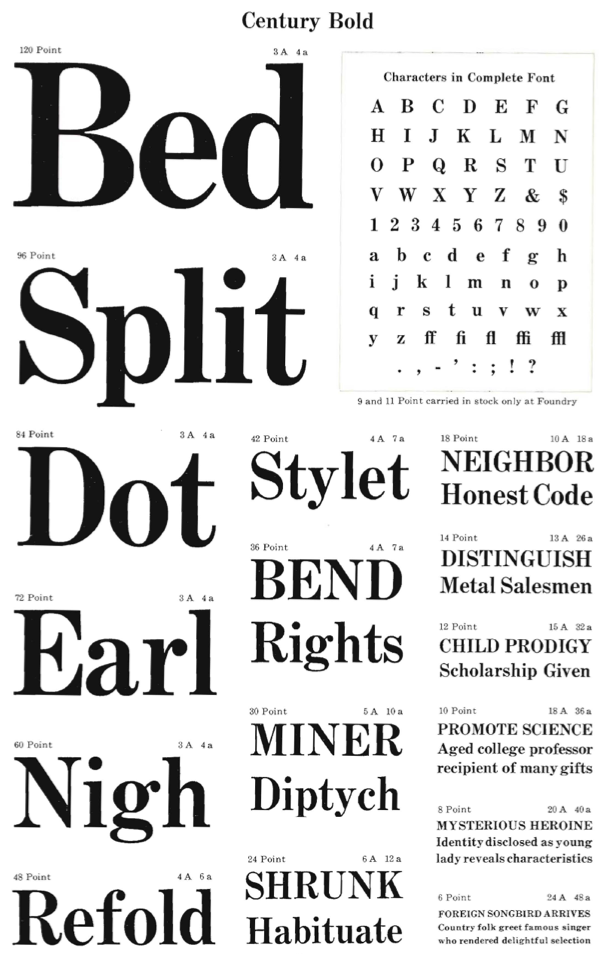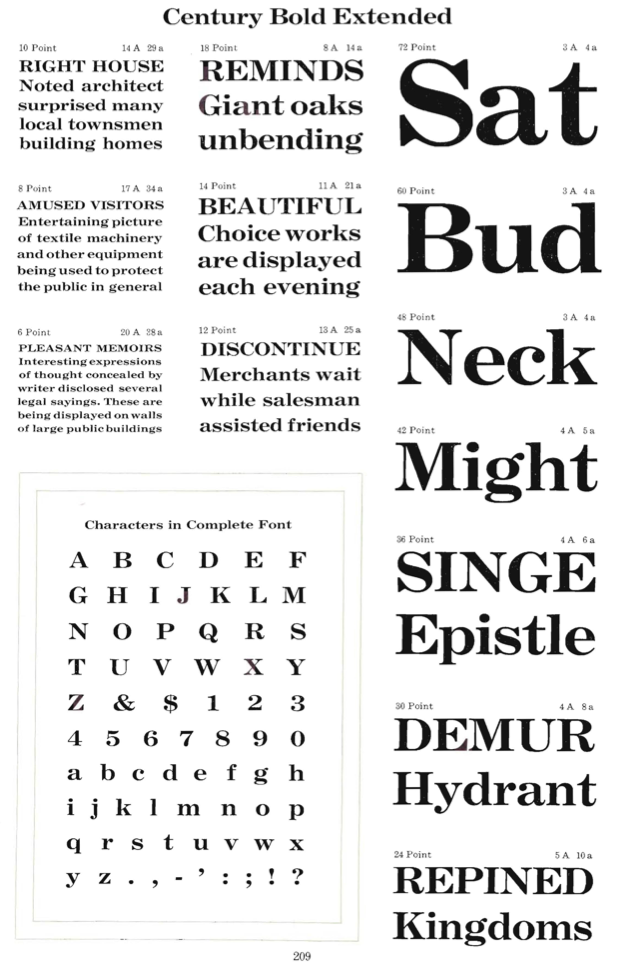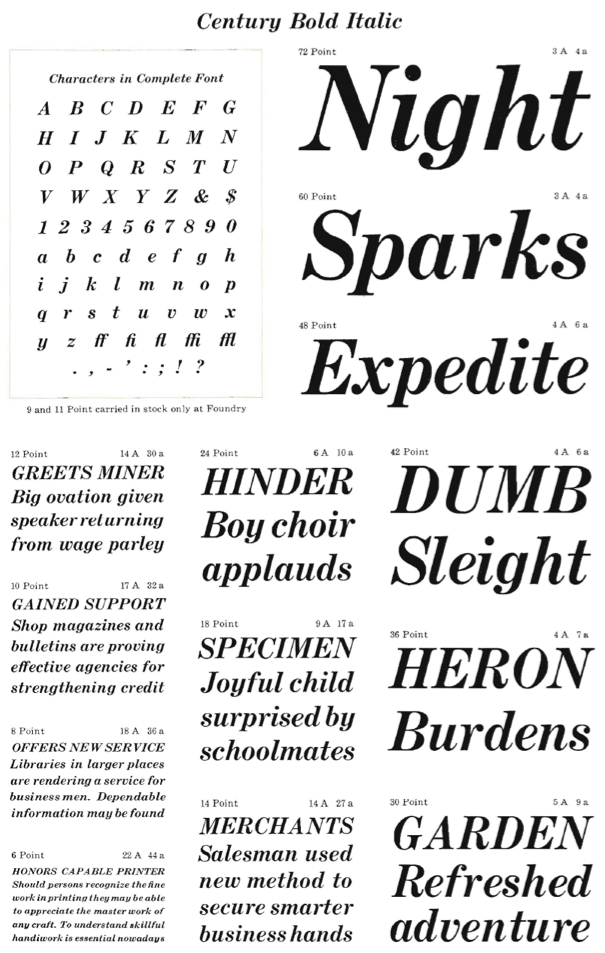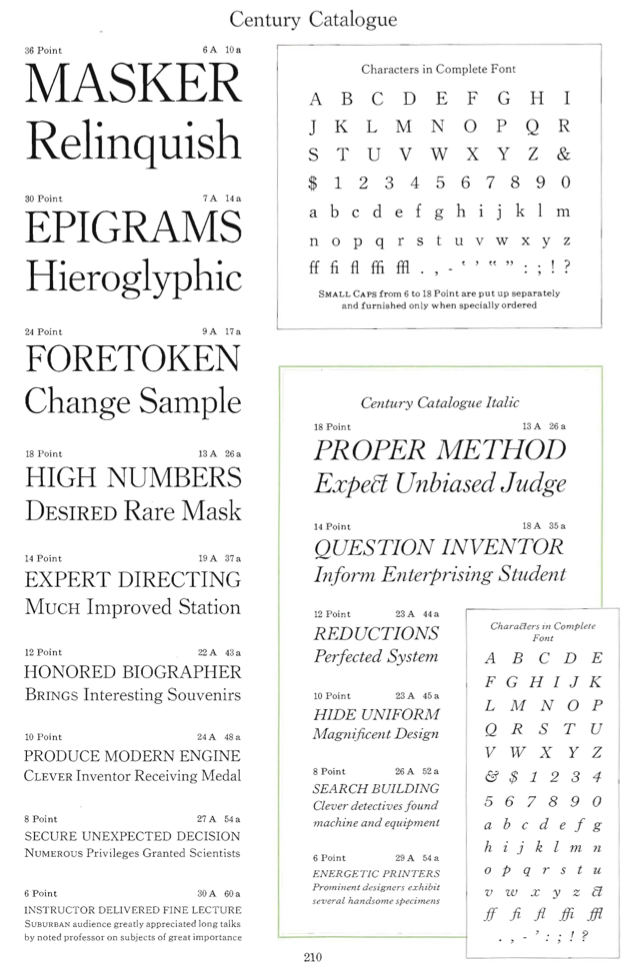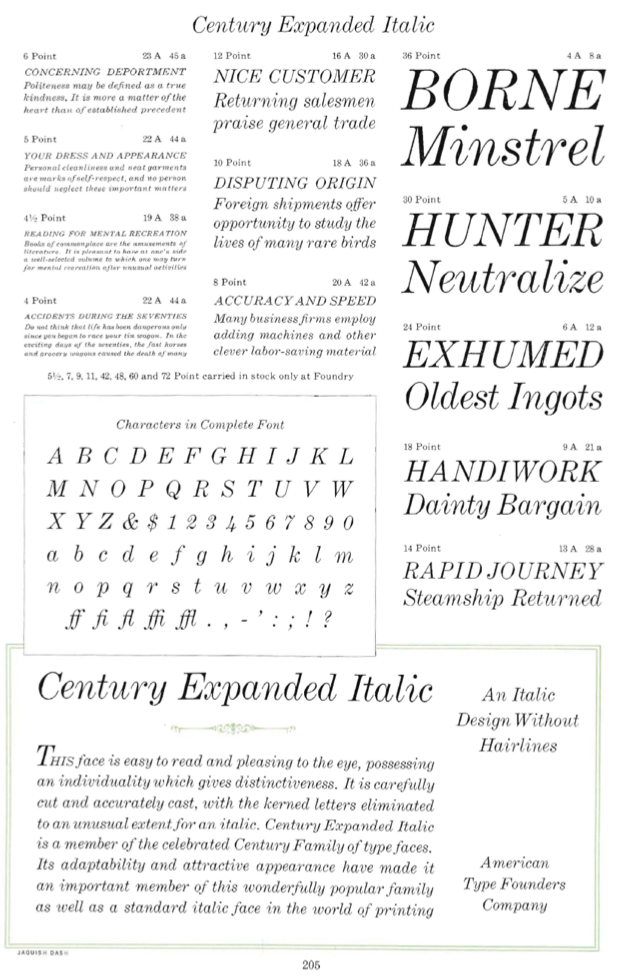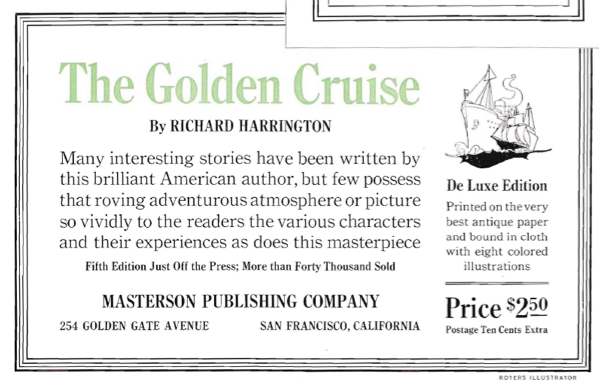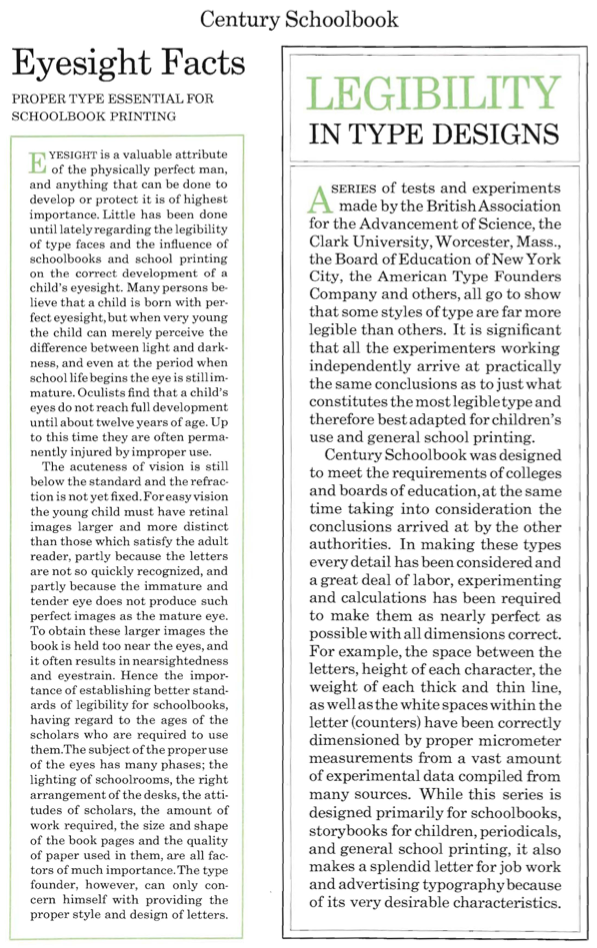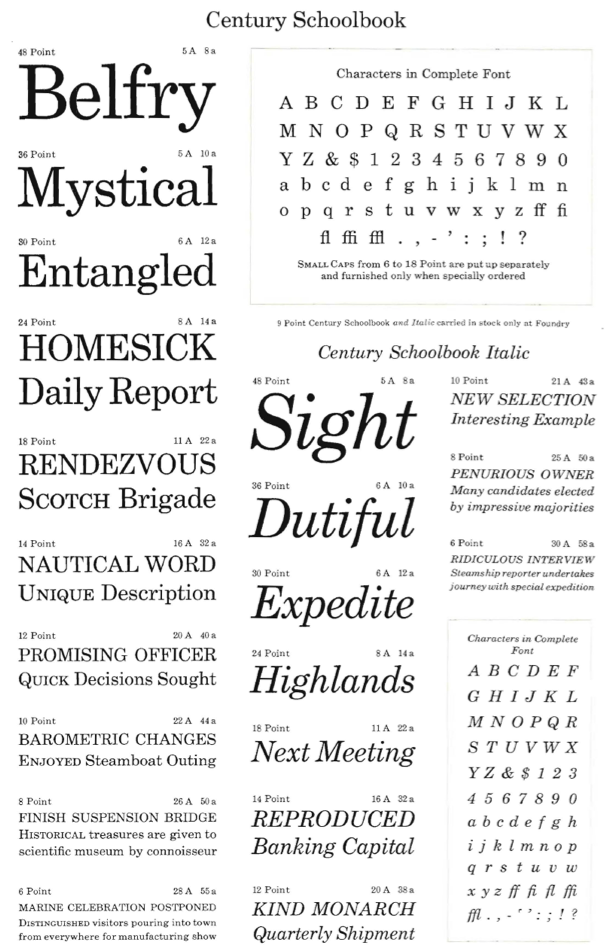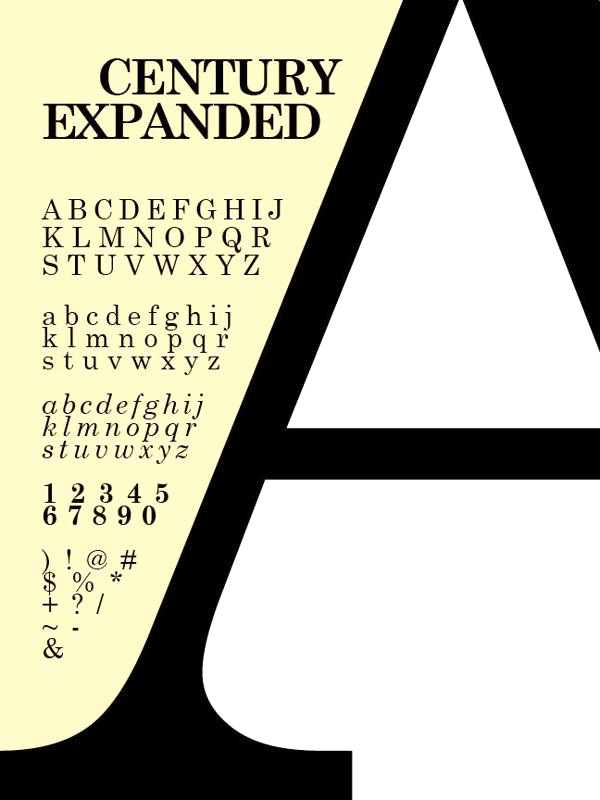|
Century

Mac McGrew tells the story of the development of Century. Quoted verbatim, with only minor editorial changes. - 1894: Century Roman was designed by Linn Boyd Benton at the request of Theodore L. De Vinne, publisher of Century Magazine at his De Vinne Press in New York City. Benton was the mechanical genius of the young American Type Founders Company. DeVinne was regarded as an outstanding printing craftsman, who was dissatisfied with the types then available for magazine and book work. As he wrote later, Readers of failing eyesight rightfully ask for types that are plain and unequivocal, that reveal, the entire character at a glance, and are not discerned with difficulty by body marks joined to hairlines and serifs that are but half seen or not seen at all. Century Roman was planned to get as many characters per line as the typeface previously used for the magazine, but because the x-height was increased, it appeared to be condensed. Hairlines were thickened for greater clearness. It was made only as foundry type, handset for several years for Century Magazine and for numerous books. Although shown in ATF specimen books, it was not used to any great extent by other printers because it was considered a little too narrow. A wider version, called Century Broad-Face or Century Roman No.2, was thereafter designed by Benton, but little used except by De Vinne.
- L. B. Benton's principal interest was the mechanical end of the typecasting industry, and he turned his attention back to this. About this time his son, Morris Fuller Benton, joined ATF after graduation from Cornell, and was assigned the task of unifying and updating the numerous styles of type the company had inherited from its many predecessors. One of the younger Benton's early assignments was redesigning Century Roman, extending it slightly to meet the Typographical Union standards of the day, on which rates for typesetting were based. The result was named Century Expanded, issued in 1900 [Image by Heather Leonhardt]. DeVinne, showing it in his company specimen book, said, The expansion is upward, enabling one to get much matter in small space---essentially what he had said of the earlier face. But it is obviously expanded in width also, compared with the original face. (Note: Some sources, including a publication by ATF itself and De Vinne's own specimen book, credit the elder Benton with designing Century Expanded. But study reveals that the typeface shown by De Vinne is not quite as wide as that later shown by ATF. Apparently the elder Benton designed an early version, cut it in one trial size, then turned the task over to his son. Undoubtedly, though, he collaborated in the redesign.). Century Expanded and Italic were made in an unusual number of sizes, including 4-, 41/2-, 5-, 51/2-, 6-, 7-, 8-, 9-, 10-, 11-point, and all the usual sizes to 72-point. The two smallest sizes were identical as to typeface except for length of descenders, likewise 51/2- and 6-point.
- 1904: Century Bold and Italic were designed by Morris Benton and released by ATF in 1905. Although the name doesn't include "Expanded," they are obviously the companion boldfaces.
- Century Bold Condensed and Extended were both designed in 1906 but not released until 1909 and 1910 respectively; both were also by Benton.
- 1938: Century Bold Condensed Italic was designed by Sol Hess for Monotype. Linotype cut Century Bold Extra Condensed as a newspaper headline typeface to fit the limits of its standard magazines.
- Meanwhile, the development of the Century family took a different turn when Benton designed Century Oldstyle in 1906. Released in 1908-09, this typeface is much like Century Expanded in weight and height, but with old-style serifs. An ATF ad in 1909 called it the newest and by far the best old-style ever designed. Century Oldstyle Bold was designed and cut in 1909 and Bold Italic in 1910, while Bold Condensed was designed in 1911 but not released until 1915. Although closely related, the Century Oldstyle family is not really a part of the Century Expanded family. Another related typeface is Schoolbook Oldstyle (q.v.). Also see University Old Style.
- Retreating, perhaps, from the large x-height of Century Oldstyle, a modified oldstyle named Century Catalogue was brought out by Benton in 1917 with longer ascenders but essentially the same general design. Curiously, Century Catalogue Italic was cut from the patterns for Baskerville Italic. Except for the caps A, V, and W and the omission of swash letters, the typefaces are almost identical in the 18-point size; in smaller sizes the Century typeface is wider, as modified by pantagraph during the cutting of mats.
- A third family of Century followed when Ginn&Company, publishers of schoolbooks, asked ATF to develop a typeface for maximum legibility. After many studies of eyesight and reading factors dating from 1912, Century Schoolbook and Italic were designed by Morris Benton in 1917-19 and released in 1918-1921. Century Schoolbook Bold was designed in 1919 and cut in 1923.
- The only Century design by an "outsider" during Benton's life, other than modifications for the composing machines, was Century Bold Condensed Italic by Sol Hess in 1938, mentioned above.
- 1964: Long after the end of Morris Benton's distinguished career, the immortal family was enriched with another member---Century Nova and Italic---designed by Charles E. Hughes, who had been commissioned by ATF for the project. This is a condensed face, following the spirit of Century Expanded. Unknowingly, Hughes brought Century back to just about the same proportions it had started with some 70 years earlier.
- Century Expanded and its variations have been copied extensively by Monotype, Linotype, Intertype, and Ludlow, under the same names. Century Schoolbook is also offered by Monotype and Intertype, while Ludlow calls its version Century Modern, offered in 1964. Some of these typefaces suffer a bit from adaptation to the mechanical restrictions of the various machines, but they are essentially the same. Intertype's Century Schoolbook Bold, though, while necessarily much narrower than the original, is a handsome typeface in its own right. Century Oldstyle is also made by Monotype, but its version differs substantially from the original; capitals are wider and fitting is looser throughout. This modification was required for keyboard sizes but was carried into display sizes as well. Linotype offered a faithful copy of Century Oldstyle in 24-point only-originally under the same name; later it was renamed Old Style No.7, although it is not at all the same typeface as smaller sizes shown under that name. Intertype offered Century Oldstyle only in 36-point, but copied the Monotype version in some small sizes under the name Old Style No.9. Monotype Century Oldstyle has another distinction. Quite a number of typefaces have alternate long descenders, but this typeface also has alternate long ascenders in the 12-point size. With these, it is suggestive of Century Catalogue. Western Type Foundry and its successor, BB&S, offered Century Roman; however, this was a copy of Century Expanded rather than the original Century Roman of ATF. Three mystery names turned up in the preparation of this section of the book. An Intertype list includes "Cent. Schoolbook Bd. with Italic," but if this means Bold Italic, no other trace of it has been found. A Monotype list includes "Century Mono-Photo, No. 520," and "Century Text, No. 618," both indicated as being made as matrices for metal typesetting, but it has been impossible to identify them otherwise.
|
EXTERNAL LINKS
Behance page
MyFonts search
Monotype search
Fontspring search
Google search
INTERNAL LINKS
History of type ⦿
Morris Fuller Benton ⦿
Baskerville ⦿
|

